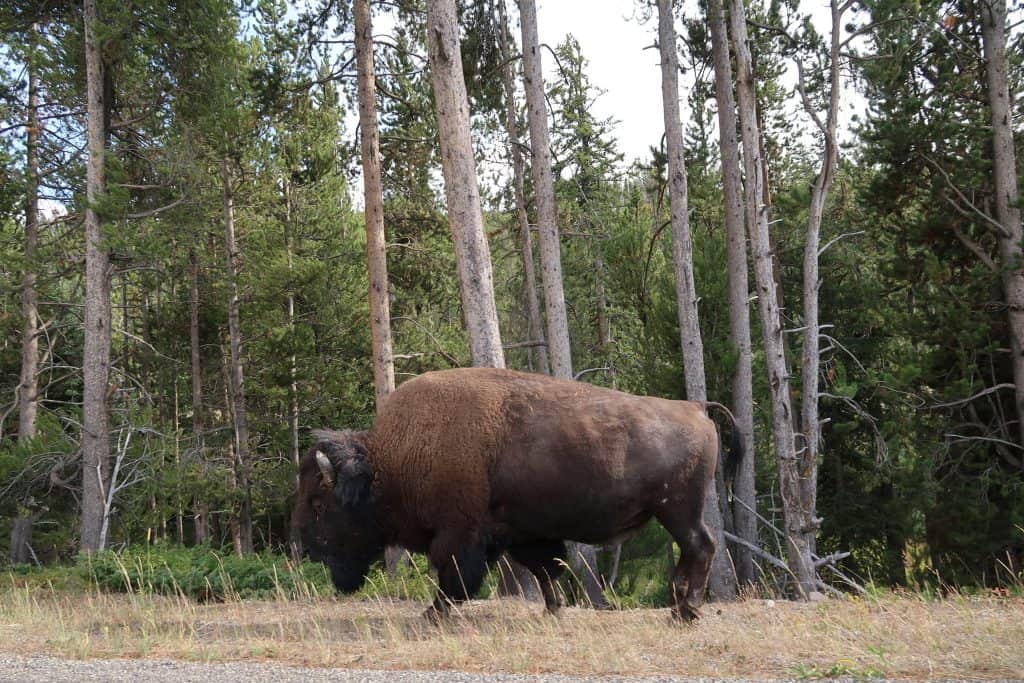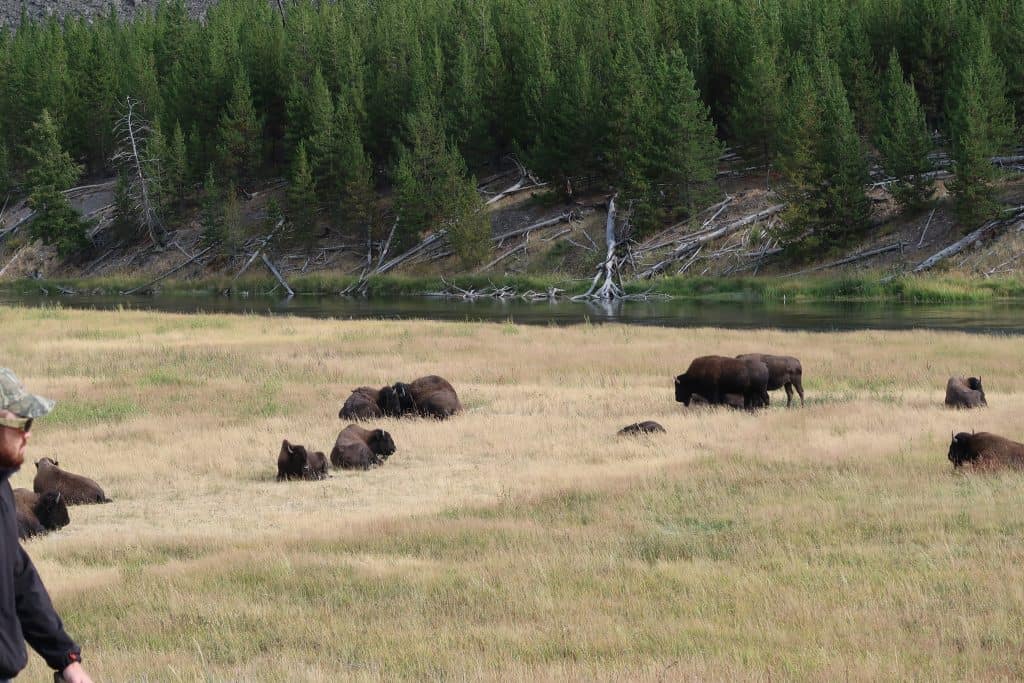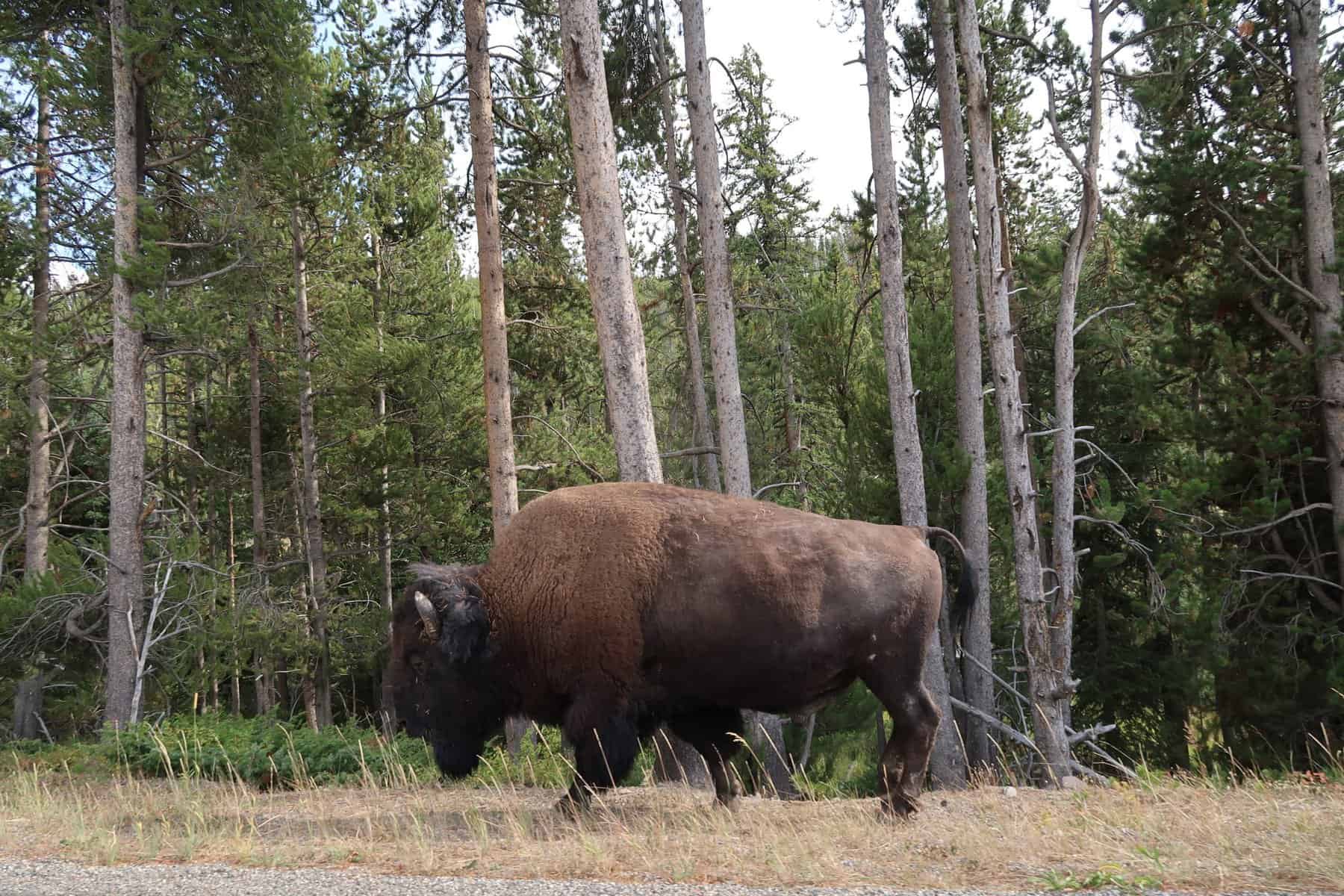Yellowstone National Park is a place of incredible natural beauty and rich wildlife diversity. Our family have been devoted to and enamoured by this park for generations. It was the United States’ first national park, and its stories of “firsts” continue today. Between the re-introduction of wolves, to the Bison Conservation And Transfer Program, Yellowstone National Park continues to be the subject of many great conservation and restoration stories.
Among Yellowstone’s most iconic inhabitants, of course, are the bison which have long been a symbol of the American West. The history of bison in Yellowstone is one of near-extinction, conservation efforts, and ongoing challenges. We’ll explore the fascinating story of bison in Yellowstone National Park.

Bison, also known as American buffalo, are large, shaggy-haired mammals that are native to North America. These iconic animals played a vital role in the history and culture of many Native American tribes that relied on bison for food, clothing, and other necessities.
Today, bison are primarily found in protected areas such as national parks and wildlife refuges where they are managed for conservation purposes. These magnificent animals can weigh up to 2,000 pounds and stand over six feet tall at the shoulder.
They are well adapted to survive in harsh environments, and they are known for their powerful build and thick fur coats. Bison are herbivores and feed on grasses, sedges, and other plant materials. Despite their size and strength, bison are also capable of impressive speed and agility. They can run up to 30 miles-per- hour.
The survival of bison populations remains a critical concern for conservationists and wildlife managers, and efforts are underway to protect and restore these iconic animals for future generations.
The Bison’s Historical Importance
Bison have played a vital role in the history and culture of North America for thousands of years. Many Native American tribes relied on bison for food, clothing, and shelter, and the animal became an important cultural symbol. Early European explorers and settlers also recognized the value of bison, both as a source of food and as a means of trade with Native American tribes.
By the mid-1800s, however, bison populations were in serious decline. European settlers had hunted bison nearly to extinction. These hunts were orchestrated to drive Native American tribes away from certain land. It is is an uncomfortable part of United States history, but one we encourage you to explore.
By the end of the 19th century, it was estimated that only a few hundred bison remained in the wild. The bison’s decline was recognized as a major conservation issue, and efforts were made to protect and restore the species.
Yellowstone’s Role in Bison Conservation
Yellowstone National Park played a critical role in bison conservation efforts. In 1902, the American Bison Society donated 21 bison to the park, marking the beginning of efforts to restore bison populations in the area. Over the next several decades, bison numbers in Yellowstone increased, and the park became an important refuge for the species.
However, the conservation of bison in Yellowstone has not been without controversy. In the early 20th century, bison were still considered a threat to agriculture and were often hunted and killed outside of the park boundaries. Additionally, in the 1960s and 1970s, bison were culled within the park in an effort to prevent the spread of brucellosis, a disease that can cause cattle to miscarry.
Bison Conservation Today
Today, Yellowstone National Park remains an important stronghold for bison conservation. The park is home to the largest remaining population of wild bison in North America, with an estimated 4,500 individuals. However, ongoing challenges, including conflicts with ranchers and the spread of brucellosis, continue to threaten the species.
In recent years, efforts have been made to find new solutions to these challenges. One approach has been to work with ranchers and other stakeholders to develop alternative grazing strategies that reduce the risk of disease transmission. Additionally, a program has been established to capture bison that leave the park and relocate them to other areas where they can help restore bison populations.

The Bison Conservation & Transfer Program
Yellowstone National Park’s Bison Conservation and Transfer Program is a critical initiative aimed at preserving the wild bison population and promoting genetic diversity.
The program involves capturing and testing bison for brucellosis, a bacterial disease that can cause reproductive issues in cattle, and then transferring healthy animals to other locations to help establish or augment existing herds. The transfer of bison is carefully planned to ensure that genetic diversity is maintained and that the animals are not exposed to disease during transportation.
Yellowstone’s bison are being transferred to a variety of locations as part of the park’s Bison Conservation and Transfer Program. Many are transferred to tribal lands where bison have cultural and historical significance and can play a role in the restoration of ecosystems and traditional practices. Private lands are also sometimes used as transfer destinations, particularly for bison that are being used for conservation breeding programs or other research projects.
Each transfer destination is carefully selected based on factors such as available habitat, disease risk, and the potential for contributing to conservation goals.
The program has been successful in expanding bison populations outside of Yellowstone and helping to ensure the long-term survival of this iconic species. However, it has also been the subject of controversy with some stakeholders calling for more extensive transfers and others calling for a reduction in the park’s overall bison population. Despite these debates, the Bison Conservation and Transfer Program remains a critical aspect of the management of Yellowstone National Park’s bison herd.
The Importance of Bison in Yellowstone Today
Bison continue to play a vital role in the ecosystem of Yellowstone National Park. As a large herbivore, bison help to shape the landscape by grazing on grasses and other vegetation. This, in turn, creates habitat for other species including predators like wolves and bears.
Bison are also an important cultural symbol in the park. Visitors from around the world come to Yellowstone to see these majestic animals in their natural habitat, and bison have become an enduring symbol of the park’s wildness and natural beauty.
The story of bison in Yellowstone National Park is one of conservation success, ongoing challenges, and enduring cultural importance. From near-extinction to a thriving population, bison have proven to be a symbol of resilience and adaptability.
While the challenges facing bison conservation in Yellowstone are significant, efforts to find new solutions and work collaboratively with stakeholders continue to offer hope for the future.
As visitors to Yellowstone National Park, we have a role to play in the ongoing conservation of bison and other wildlife. By respecting park rules and guidelines, staying a safe distance from wildlife, and supporting efforts to conserve bison and other species, we can help ensure that these iconic animals continue to thrive in their natural habitat for generations to come.

